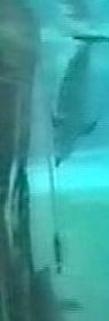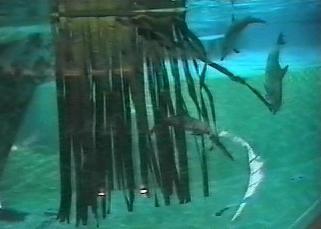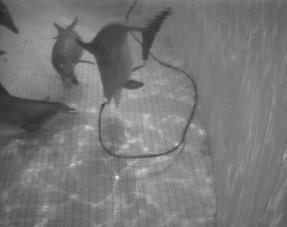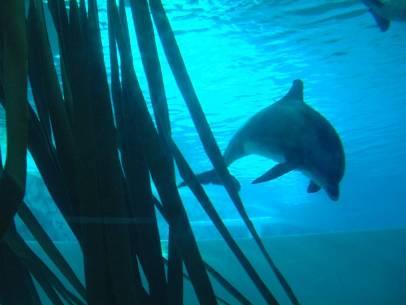
Porpoise Detectors
Four digital Porpoise Detectors (PODs) were deployed in the pool complex monitoring the sonar activity. Two pods were deployed in open spaces to constitute potential visual and acoustic landmarks and two were deployed in smaller spaces to constitute potential obstacles in spaces harder to navigate in. Sonar sound recorded by PODs in all four locations over a 24-hour-period show that the general sonar activity was low and almost none during night hours. The two pods in open surroundings recorded a higher sonar activity compared to the two pods in smaller spaces. This contradicts the expectation of a greater need of sonar in a space, which is more difficult to navigate in. These results could indicate that objects in open surroundings were used as landmarks.

The Kelp Imitation
The acoustical target strength in an artificial kelp algae-imitation was increased with air-filled net floats. This device intended to visually simulate a natural like coastal area in which the sight is limited. Improving the acoustical strength of this device added a potential acoustic landmark in the environment. Results show that the presence in the pool increased along with the sonar activity with improved acoustic target strength. This could indicate that objects with good acoustic reflection were used as landmarks.

The Interactive Hose
A hose set in motion by high pressure running water in direct response to sonar sound was introduced in the pool. This device intended to provoke hunting behaviour with which sonar use is associated. This device showed a significant increase in sonar activity. The moving hose triggered hunting correlated displays such as long intensive sonar click trains locked on target and hunting group formations similar to observations made in wild dolphin schools.
By looking at the inter-click-intervals of recorded click data the proportion of the sonar activity within a close range from the device and proportion of sonar activity within a long distance range can be calculated. This can show to what extent objects with good acoustic target strength are used as landmarks.
Conclusion

The dolphins responded positively to tested acoustic enrichment additions, indicating that this kind of enrichment should be further exploited in order to improve the acoustic aspect of a pool environment. Enrichment techniques tested here could beneficially be implemented in existing pools.
- For other forms of presentation see list in the upper left corner -
Responsible for this page:
Director of undergraduate studies Biology
Last updated:
09/06/05
